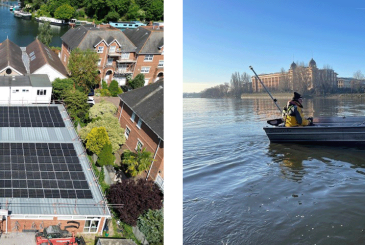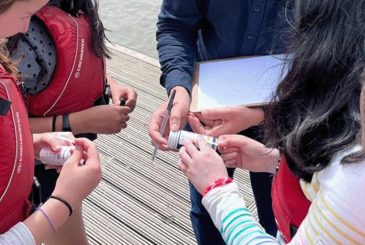As the new season gets going, Toby Bryant talks to six clubs across the country to find out about their life after the heat of the pandemic
In early March 2020, rowing clubs were going about their daily lives, looking ahead to a promising regatta season as a Covid-sized cloud loomed threateningly overhead.
Murmurs of the pandemic came from far-flung countries and, as rowers clambered into boats and tightened gates, few thought the virus would have a major impact in the UK.
Then, almost overnight, rowing clubs were forced to hand out rowing machines, close their doors and bid goodbye to members for a month.
Except, it wasn’t to be a month, it would be 18 and it is only now that the country’s clubs are fully whirring back into action.
As life returns to normal, it’s understandable that the overwhelming feeling is one of optimism and a desire to put the pandemic in the past. However, for many clubs, life will never be the same.
Luckily, thanks to supportive members, financial grants and robust committees, most British clubs weathered the storm. In that process, the way our clubs work has changed so we spoke to six across the country to find out how they coped and what the future looks like.
Upton Rowing Club – engaging members and returning to row

At Upton Rowing Club, members had just spent three months off the water due to flooding at the start of 2020 and were raring to get rowing again when news of the pandemic hit.
Jo Hammett told us: “We’d just had three months off the water and were wondering whether to refund people’s memberships. Then Covid came along and it was just a nightmare.
“We had started opening back up again and were due to do our five-year plan and we thought, we’re going to need a one-year survival plan here.”
“We put a banner on the main road up to Upton, saying ‘why not return to row’, and we got an unprecedented number of people”
The committee resolved to do all they could to “just keep the club going”.
Jo admitted that, although they had their work cut out, the club knew it could battle through if they could keep members interested – in doing so ensuring high spirits and membership fees.
She said: “We knew we’d get through this, but we had to do something extra, not expect it to fall in our laps.
“We offered people a partial refund if people wanted to take it up, but hardly any did.”
Upton were one of many clubs that benefitted from grants to help pay rent and insurance, but still needed an extra boost to bounce back after the pandemic. Jo and the team targeted the learn to row courses for that.
She said: “We just kept it simple and put a banner on the main road up to Upton, which is a real crossing point, saying ‘why not return to row’, and we got an unprecedented number of people.”
The success proved great news for the club.
Birmingham Rowing Club – investing and new technology
Like many others, Birmingham Rowing Club kept members engaged during lockdowns by thinking creatively. Where some decided to save money and act cautiously at that time, Birmingham decided to spend their budget.
Mindy Hothi explained the thinking: “People know me as someone who is always spending money.
“I think in the past people worried too much about making large financial decisions and that’s because we didn’t have the information to give people the confidence to make those decisions.
“You need to spend. The money depreciates, so it’s better to spend on something than to sit on it.
“I continued that philosophy during the pandemic, and we did the same from grants too.”
The club invested in activities, including a new yoga instructor, and as a result went strong during lockdowns.
Instead, it was when returning to in-person training that the club hit some turbulence.
Mindy said: “The biggest time we did feel an effect was when there was a drop in engagement and then when we opened rowing back up when some people didn’t come back.
“When we noticed people weren’t coming back it was more because of older members having those worries about being exposed. Other people’s lives had changed too and didn’t come back.
“The fall wasn’t massively dramatic – it was just a loss in certain areas – mainly the recreational older members and the intake of learn to row members.”
However, Mindy also admits that the club is actually in a better place now after all they got through together.
He explained how the running of the club is more streamlined thanks to technology: “Taking advantage of systems like Zoom, where you can have meetings without cramming everyone into one place, we’re getting better attendance at those than previously when we might have to have organise a venue.
“Nowadays the club runs everything through a shared document space too. Just getting people working in the 21st-century has been really good.”
Shanklin Sandown Rowing Club – coastal community support

Over on the Isle of Wight, Shanklin Sandown Rowing Club was one of the clubs going about the business as usual in March 2020.
Garry Walters remembered: “We had a local head race the Saturday before it all kicked off on the Thursday. “Even then it didn’t cross your mind that could happen in five days’ time.”
“We didn’t lose anybody, they just waited in the wings. It’s like a coastal family”
The club, just like the country, went into lockdown but was buoyed by the support of members.
Garry recalled that there “was never any resistance” when it came to members supporting the club through membership fees.
Having the community of a tight-knit coastal rowing scene and the community of the Isle of Wight helped with that support.
He said: “We didn’t lose anybody, they just waited in the wings. It’s like a coastal family.”
As a result, Shanklin was able to offer the following year’s membership at half the price and benefitted from a couple of grants too.
Garry said: “We’ve caught up with boat repairs and invested in new equipment, blades and ergos, and did some club refurbishment. It was an ideal opportunity to do that.”
Bristol Ariel Rowing Club – engaging members and sharing out responsibility
Bristol Ariel’s Go Row Indoor rowers were pounding away at the ergos when Geoff Lester made his way into the room having just watched PM Boris Johnson’s speech.
He broke the news that it would be the members’ last session for the foreseeable and the club would have to come down.
Geoff said: “We had some anxiety about membership – most of our members do pay monthly.
“We immediately recognised that some would be in financial difficulties as a result of the emergency measures so accepted that some would suspend their subscriptions.”
However, not many did pull out and the club went above and beyond to keep rowers engaged virtually.
Being one of the country’s clubs that offers the Go Row Indoor scheme, Bristol’s membership numbers had a greater backstop than many others.
Geoff said: “On a normal year they’ve been providing six to eight thousand extra pounds, some of that, of course, goes to the personal trainer who runs the classes.”
“Bristol Ariel helped facilitate a happy return to training by liaising with other clubs on the stretch of water”
And, even though the pull of a return to water sessions wasn’t there for those members, they also came back keen.
Geoff added: “Since we opened up, I’ve been pleasantly surprised how many who we haven’t seen for 18 months have just come back and got straight back into it.
“There’s clearly a feeling of wanting to do the class.”

For those coming back on the water, Bristol Ariel helped facilitate a happy return to training by liaising with other clubs on the stretch of water.
Geoff said: “What we really wanted to avoid was the Chinese whispers of, ‘up the river they’re out in singles and doubles, but you are restricting it’.
“We wanted to quell all of that. So, the captains were meeting and coordinating.”
That’s all aided a booming return to rowing, successful learn to row courses helping the club to its biggest membership in many years.
Geoff put that down to keeping members engaged and sharing out responsibility over lockdown.
He said: “Asking people to do things gets them hooked in.
“We engaged a lot of people in doing things – the classes for instance, there were six different people running those at one point.
“There were people who would volunteer to pass by the club on their daily exercise to check on everything – not just committee members, all members were involved.”
Lakeland Rowing Club – spending to survive and thrive
At Lakeland Rowing Club, committee members first thought the pandemic would be “something pretty terrible, but pretty short term”.
Those are the words of Alex Morgan, who would soon realise that “Covid was going to cost us all our income for what would, eventually, be a year.”
Lakeland only lost a few members but felt the impact of not being able to recruit new rowers over that period.
The club benefitted from grants and also took the approach of investing during the locked down months with the hopes of big recruitment after.
“Lakeland helped consolidate interest by including a year’s membership into the price for the [learn to row] course”
Alex explained: “We’re always needing new boats as we have an elderly fleet.
“We wet-launch straight into a very rocky bottomed lake and, with our large contingent of new rowers, our boats take a lot of punishment.
“We try and take care of them, but they have a shorter life span than other clubs.”

On top of regular expenditures were additional costs to return from the pandemic safely.
Alex said: “It was things you might not think about.
“Our coaching launch was a big heavy boat that needed half a dozen people to launch it safely.
“If social distancing continued, you couldn’t launch a boat like that, so we had to get a new launch we could launch with two people, so that we could teach new rowers to get the new income to survive.
“We almost had to spend our way out of this to make ourselves more desirable to bring people in.”
The spending was worth it and now the club has nearly doubled its members.
As well as the new equipment, that success came from the learn to row scheme.
Lakeland helped consolidate interest by including a year’s membership into the price for the course.
Alex said: “In not asking them to pay for the course and the club they are automatic members, and they don’t need to make that decision to spend a second amount of money.”
Staines Rowing Club – new boathouse and schools programmes

It’s 1951 and Staines RC is having a temporary structure put up to use as a boathouse.
Fast-forward 69 years to 2020 and it’s still standing, although not for too much longer as a new structure is being built. Then the pandemic arrives and everything is put on hold.
Jeremy Pollen said: “It was a worrying time for us, especially as we were right in the middle of building our clubhouse.”
Despite that, the club’s first thoughts turned to its thriving junior section.
“Not only did old members come back, but the club’s involvement in the local community paid dividends”
Jeremy said: “The boat club forms a crucial part of their lives and I could see them being at a loose end not being able to row and socialise with everybody. They get a lot out of that.
“When we had the green light to start training again, we had every single junior come down, they were all desperate to come back.”
Not only did old members come back, but the club’s involvement in the local community paid dividends.
Jeremy said: “Dudley Fletcher has done a number of schemes with the local schools to get them involved as well.
How is your club doing?
We’d love to hear how more clubs are faring across the country. Please contact [email protected] to let us know
Photos: Aaron Sims










